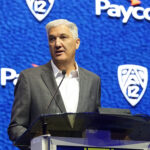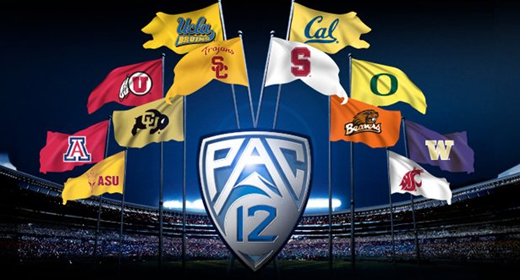Please note: Some questions have been edited for clarity and brevity.
Can you explain the ‘liabilities’ issue within the Pac-12 fight? What exactly are the liabilities the 10 outbound schools are trying to stick the two remaining schools with? — @metalhumdrum
We’ll start with this topic because it’s receiving the least amount of attention in the Pac-12 legal battle yet is deeply connected to the fight over revenue and assets.
What are the liabilities? How significant is the financial exposure? And which schools will be on the hook?
The Hotline has attempted to pin down the list of liabilities for months, and none of our contacts are exactly sure. The attorneys likely have a decent handle on the situation, but their information is part of the mediation — and nobody is talking about the mediation.
Here’s our best guess:
*** Comcast
Commissioner George Kliavkoff’s statement in court filings earlier this year indicates Comcast is withholding $72 million in distributions to the conference. The amount can be split into two buckets, according to a source:
— Distributions withheld by Comcast to offset 10 years of overpayments (2013-22) based on the company’s flawed tracking of Pac-12 Networks subscribers. That total is $58 million.
— Reductions in distributions in the 2023-24 fiscal years to account for a correction in the subscriber figures. That total is $14 million.
Timing is crucial: Both the withholding and the reduction (total: $6 million per school) are underway and expected to be completed before the end of the current fiscal year. This liability won’t linger for Washington State and Oregon State beyond next summer.
*** Dish
The conference has taken DISH Network to court for withholding distribution payments and violating the terms of its agreement with the Pac-12 Networks.
The source of the dispute? The COVID-shortened 2020 football season, in which the Pac-12 Networks were unable to meet contractual requirements to their distributors. Unlike the other partners, Dish is attempting to use COVID to justify withholding payments for additional years.
The Hotline believes approximately $10 million is at stake, based on our reporting and court documents.
*** Wrongful termination
The conference has been sued by former Pac-12 Networks president Mark Shuken and former CFO Brent Willman, who believe they were wrongfully terminated (in January) for their roles in the Comcast overpayment scandal.
The plaintiffs are seeking damages “in amounts to be established at trial and believed to be in excess of $2 million,” according to the complaint.
*** Holiday Bowl
UCLA backed out of the 2021 Holiday Bowl hours before kickoff (against N.C. State) following a spate of positive COVID tests.
After saber-rattling on both sides, the bowl’s governing body filed a lawsuit in May that names both the Pac-12 and the UC Board of Regents as defendants. It seeks at least $3 million in damages.
*** San Ramon
Kliavkoff committed to office space for the Pac-12 Networks production studios in the Bay Area city of San Ramon before he secured a media rights deal that would keep the conference together.
Based on information gathered from sources and court documents, the lease payment is approximately $2 million per year for at least five years and began this summer.
That’s about $10 million in total, with only one year covering the time all 12 schools are competing together.
*** Kliavkoff’s contract/other expenses
The conference has not released the terms of Kliavkoff’s deal. But if we assume he signed a five-year agreement — and based on figures reported in Pac-12 tax filings — it’s reasonable to conclude that he would have $7.2 million remaining on his deal beyond the end of the current fiscal year.
That could change, perhaps, if he’s fired for cause (i.e., gross negligence), but that course of action would assuredly spark another wrongful termination suit.
And let’s not forget the costs associated with the Pac-12’s employee retention and severance plan and any operational expenses that might seep into the 2024-25 fiscal year.
*** NCAA lawsuits
The most difficult liability to detail is also the most daunting: Damages resulting from antitrust lawsuits against the NCAA. One case, in particular, could carry hundreds of millions of dollars in financial exposure for the Pac-12: House vs. NCAA.
Named after former Arizona State swimmer Grant House, the suit seeks $1.4 billion in damages related to name, image and likeness, according to court documents reported by USA Today, and damages are tripled in antitrust cases.
The Pac-12, ACC, Big 12, Big Ten and SEC are defendants, along with the NCAA.
The Hotline cannot begin to guess how House will turn out, so let’s remove that item from the liabilities list. Also, let’s back the Comcast withholdings out of the tally — the process was agreed to by the schools and is underway.
Best guess? The conference is staring at approximately $35 million in liabilities.
Split 12 ways, that’s about $3 million per campus.
Split two ways, that’s … a ton.
If the ‘Pac-2’ indeed retains control after an appeal, what is the most realistic outlook for the 2023-24 media rights revenue shares? — @Cargoman0363
ESPN, Fox and the Pac-12 Networks distribution partners are under contract through the spring. As long as the Pac-12 delivers the requisite inventory, the money will flow regardless of the lawsuit.
How much? The revenue figure for the current competition year cited in legal filings is $420 million, which is $35 million per campus if split equally.
Even if they win the legal fight, Washington State and Oregon State won’t take all of it. That would land them right back in court.
We believe a settlement is the best resolution, with the 10 departing schools walking away with $25 million (or so) and the two remaining schools using the extra revenue, and the long-term assets, to fund operations and set their schedules for 2024-25.
Should the Mountain West have any trepidation about the scheduling alliance with Oregon State and Washington State knowing that the ‘Pac-2’ might try to rebuild the conference with some of the MW’s best schools? — @Milkbear79
I’m sure some Mountain West schools are worried about downstream poaching by the ‘Pac-2’ that would grab the best football programs in the MW, with others getting left behind.
And for that reason, any schedule alliance likely will feature contractual protections for Utah State, San Jose State, Nevada, New Mexico, etc.
For the top-tier MW schools, a schedule partnership with the ‘Pac-2’ seems like an easy call — those are quality home games for Fresno State, Boise State and San Diego State — as long as the financial terms are acceptable.
The Cougars and Beavers must make the deal worthwhile, after all.
Is there any mood to continue state rivalries in the Pacific Northwest? It would be very easy to do if Oregon and Washington each drop a cupcake to help fill the OSU and WSU schedules. Or are feelings too raw? — @WorkishFromHome
Feelings are raw, for sure, but cooler heads are working to continue the two in-state rivalries. In fact, the Hotline has been told the Oregon schools and Washington schools are “close to getting deals done.”
In addition to the history, the matchups generate quality TV ratings and have value to media companies.
I can’t state conclusively that the Apple Cup and the game formerly known as the Civil War will be played next season, but the Hotline is 95 percent certain you’ll see the rivalries continue without interruption.
As for the date, circle Sept. 14, 2024. Washington has an opening on its schedule to play WSU, and Oregon is reportedly attempting to create one in order to face OSU.
There seems to be differing information between you and Yahoo regarding the College Football Playoff’s ability to change the rule about requiring eight teams in a conference to get an automatic bid. Yahoo says it doesn’t require a board vote, but you’re saying it does. Who’s correct? — @eWrecK__
Easy answer: There was some confusion about this aspect of CFP governance and whether the commissioners (i.e., the management committee) could make the change or whether a unanimous board vote (i.e., the presidents) was required.
Our report was based on an interview with WSU president Kirk Schulz, a member of the CFP board, late last week.
Late this week, CFP executive director Bill Hancock clarified to Yahoo’s Ross Dellenger that the commissioners do indeed have the authority to set the minimum requirement (eight teams) for automatic bids.
Keep in mind that everything about this is unprecedented. The CFP didn’t contemplate the possibility of a two-team conference when it established the selection policy a decade ago.
Hope that helps.
What is the CFP committee trying to protect against with the rule on how many teams are required for a conference to receive an automatic bid? Oregon State and Washington State will be a two-team conference for no more than two years. If they end the season ranked high enough, what’s the harm in them claiming the automatic bid? — @keithdennis
The harm is that there are only 12 spots, and every spot in the expanded event will be worth tens of millions of dollars.
Those leagues believe there will be enough disparity in the schedules that the Cougars and Beavers should not have the same access as champions of the Power Four leagues.
If the ‘Pac-2’ winner receives an automatic bid, that’s one less berth for at-large teams from the SEC, Big Ten, Big 12 and ACC.
And remember, all the changes are for the 2024 and 2025 seasons. There are no policies in place once the CFP’s contract with ESPN expires early in 2026.
How much do Oregon State and Washington State need from the Pac-12’s remaining funds to buy their way into the Big 12 the same way Cal, Stanford and SMU bought their way into the ACC? — @bbm010
There is no amount, because the Big 12 is finished expanding and anyone who reports otherwise is either misinformed or just making stuff up.
Could things change much later this decade or in the early 2030s? Sure, the sport is due for a massive structural shakeup when the next round of media rights negotiations commence.
But for now, all paths into the Power Four leagues are blocked for the Beavers and Cougars, at any price.
The Big 12 is content and aligned with 16 teams, as are its media partners.
Are Stanford and Cal regretting their decisions to leave for the ACC (and the massive financial sacrifices needed for membership) given success thus far of the ‘Pac-2’ lawsuit? — @metalhumdrum
The Hotline believes both Bay Area schools are deeply conflicted about the situation.
They wanted the Pac-12 to stick together and planned on the Pac-12 sticking together — to the point that they expected the grant-of-rights to be signed on the morning of Aug. 4.
But once the collapse unfolded, the Cardinal and Bears quickly became convinced the ACC was the best spot for their athletic departments — even at huge cash discounts over the 12-year contract.
(The schools will reportedly receive 30-percent shares of the ACC’s Tier 1 media revenue for seven years and won’t reach full shares until their 10th year.)
There is no indication that developments in the Pac-12 lawsuit have changed their opinions.
Had the schools remained in the Pac-12 with Washington State and Oregon State and won the lawsuit — as plaintiffs in the case against eight outbound schools — the same issues would exist.
Specifically, Stanford and Cal would have faced significant reductions in revenue, and their athletes, especially in the Olympic sports, would have experienced a substantial drop in competition.
For both, the Olympic sports were a huge piece of the ACC calculation.
*** Send suggestions, comments and tips (confidentiality guaranteed) to pac12hotline@bayareanewsgroup.
*** Follow me on Twitter: @WilnerHotline
*** Pac-12 Hotline is not endorsed or sponsored by the Pac-12 Conference, and the views expressed herein do not necessarily reflect the views of the Conference.
Related posts:
 Hotline Mailbag – How much longer for Edwards at ASU, Kliavkoff impact, more
Hotline Mailbag – How much longer for Edwards at ASU, Kliavkoff impact, more 
(AP Photo/Damian Dovarganes, File)
Pac-12 survival: Oregon, Washington to deliver the death blow, leave for the Big Ten; more defections expected
(AP Photo/Lucas Peltier)
The Pac-12’s stellar football season, the media rights collapse and the enduring disconnect that defines the conference Mailbag: The problem with promotion and relegation, options for WSU and OSU, Kliavkoff’s duties, the Pac-12 Networks’ future and more
Mailbag: The problem with promotion and relegation, options for WSU and OSU, Kliavkoff’s duties, the Pac-12 Networks’ future and more
